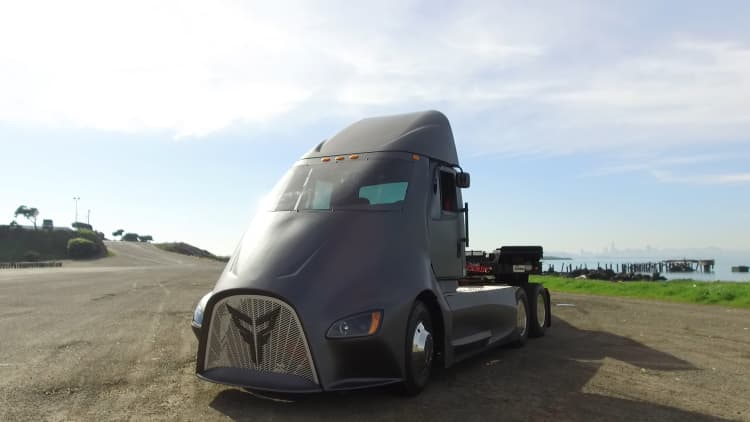
Tesla soothed some investor concerns Wednesday by delivering fourth-quarter results that beat analyst expectations, reiterating that it is on track to reach its latest Model 3 production goals, and slowing its white hot cash burn rate.
However, the company did say it will spend more capital in 2018 than it did in 2017.
Here's how the company did compared with what Wall Street expected:
- Adjusted loss per share: $3.04 vs. $3.12 expected according to Thomson Reuters
- Revenue: $3.29 billion vs. $3.28 billion expected according to Thomson Reuters
In after-hours trading Wednesday, shares of the company bounced around, but were currently flat.
Some analysts had expected Tesla's cash burn to slow down, but warned that it remains a risk. Tesla said it is deferring some capital expenditure payments for the Model 3 to the first quarter of 2018.
The company expects capital expenditures to be slightly greater in 2018 than in 2017, and the majority of that is expected to go to increasing production capacity at both the Gigafactory in Nevada and in the Fremont plant, as well as for building stores, service centers, and Superchargers.
Tesla reported negative free cash flow of $276.7 million, compared with $1.4 billion in the previous quarter, and $969.8 million in the fourth quarter last year.
Tesla said it is on track to meet its goal of producing 5,000 Model 3 cars a week by the end of the second quarter, executives said Wednesday. Tesla had originally planned to reach the target by the end of 2017, but has since moved the deadline twice. The company plans to hit a production rate of 2,500 cars per week by the end of the first quarter.
Once it reaches its 5,000 per week target, Tesla's next focus will be on hitting its planned 25 percent gross margin.
Tesla also expects quarterly operating income will turn positive once it achieves this pace, according to CEO Elon Musk, speaking on the company's earnings call.
"I am cautiously optimistic that we will be GAAP profitable, with no asterisk" in 2018, he said.
Musk also continues to expect the company will be producing 1 million vehicles annually by 2020. But first it needs to ramp up Model 3 production.
Producing the Model 3, a sedan that starts at $35,000, on a mass market scale is widely considered crucial to Tesla's ambition of becoming a major automaker. Hopes that it will hit this target are considered one of the primary factors that have pushed Tesla's share price far above those of its much larger and profitable U.S. competitors, Ford and GM.
Tesla has had challenges hitting its production targets due to manufacturing difficulties. As CNBC has reported, current and former employees say the company may have further trouble ramping up production, due in part to problems at Tesla's Gigafactory near Reno, Nevada.
As for its higher-priced Model S sedans and Model X sport utility vehicles, Tesla said it delivered a record number during the quarter. Model S and X deliveries grew 10 percent globally over Tesla's prior record in the third quarter, and were up 28 percent compared to the fourth quarter of 2016.
Despite concerns Model 3 sales would cannibalize sales of these pricier models, Tesla said customer foot traffic has increased considerably in stores where the Model 3 is on display and orders for Model S and Model X have increased.
The company expects to deliver 100,000 Model S and X vehicles in 2018. Tesla said production will be constrained by the supply of cells with the old 18650 form factor. Tesla uses the 18650 lithium battery cells in its Model S and X, while other products use the newer 2170 format the company developed. Tesla plans to adjust its mix of available options to maximize margins.
Musk told analysts on a conference call that he plans to make capital investments related to the Model Y SUV toward the end of the year.
Tesla said it posted a loss of $675 million, or $4.01 per share, in the latest quarter, its biggest loss ever. A year ago, Tesla lost $121 million, or 78 cents per share.
After adjusting for one-time items, the company lost $513 million, or $3.04 per share.
Tesla's energy business saw an increase in sales of its Powerwall storage battery, Tesla said. The company expects sales of energy storage products to triple in sales and gross margins to improve in 2018.
Tesla opened 12 new store and service locations, for a total of 330 locations around the world at the end of 2017. Tesla increased productivity at existing service stations by 50 percent, doubling service capacity. Tesla's Mobile Service performs 30 percent of all service jobs.
Tesla also opened 338 new Supercharger locations throughout the year, for a global total of 1,128 stations. Along with the company's Destination Chargers, Tesla increased charging capacity by over 90 percent.
WATCH: This electric semi is trying to beat Tesla to market



